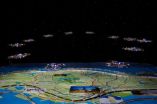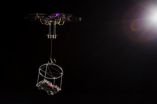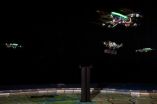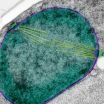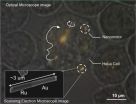(Press-News.org) Nanyang Technological University (NTU) will be showcasing its latest R&D expertise in Unmanned Aerial Vehicle (UAV) technology at the Singapore Airshow, one of the most important aerospace and defence exhibitions in the world, held from 11 to 16 February.
Visitors to the Singapore Airshow will be able to see 12 drones, programmed by NTU scientists and researchers, flying in formation within inches of each other and executing complex indoor aerial manoeuvres.
In addition to the formation air-show by 12 quad-rotor Unmanned Aerial Vehicles complete with strobe lights and music, visitors will also be able to play various games using the drones.
Leader of the team, Professor Low Kin Huat from NTU's School of Mechanical and Aerospace Engineering, said they hope to bring scientific R&D closer to the public, in order to let them better understand the importance of science and engineering and what it can achieve.
"NTU has deep expertise in robotics and UAVs in the last two decades, so putting up such a large indoor aerial showcase is a testament to the capability of our UAV research team," said Prof Low.
"UAV hardware can be easily bought off the shelf, but expertise know-how in programming is not as easily acquired, hence the need to do research and to train manpower in this field," added the robotics expert, who has groomed some of NTU's young talents in the field.
"With growing interest by businesses to use drones as delivery vehicles, and to be autonomous aerial cameras for mapping and observation purposes, it is important that Singapore and NTU continue at the cutting-edge of such technology.
All the UAVs used for the aerial display are custom-made according to the team's designs. The software which programmes the drone movements were developed from scratch in Singapore by the NTU team over a period of three years.
Each UAV is made up of a carbon fibre frame, with four rotors that are six to eight inches long. On it are radio control modules, sensors and electronics, complete with a battery pack. For the UAVs to fly in a certain pattern, the team has to first upload their specified pathways to their unique software, which then programmes the flying instructions for each of the 12 drones.
A big challenge lies in ensuring that the UAVs do not collide while flying in close proximity to one another, as there are certain factors beyond human control, such as unpredictable sensor noises or equipment interference emitted by the drones.
Properly coordinated path planning and control were crucial in maintaining the desired flight patterns of the UAVs.
The exact positioning of each drone is determined by more than 30 video cameras mounted over the indoor stage, which is 10 metres long and wide, with a height of 5 metres. The UAV flight formation, which is fully autonomous, includes unique manoeuvres only doable by rotatory aircrafts, such as hovering and flying from side to side.
Hands-on experience for visitors at NTU's booth
Visitors to NTU's booth at the Airshow will get to experience the university's UAV know-how via interactive games. In the "Commando" game, the player pilots a UAV into the centre of the stage to pick up an object guarded by three other flying UAVs. After picking up the object, the player's drone will have to escape and drop off the object into a nearby receptacle.
Another interesting game is the "Hot Pursuit" where the player drives a remote control car down a race track to avoid being hunted down by an automated UAV.
In both the games, the objective is to do it in the shortest time possible and to set a daily record.
The third game is called "Quad-ligraphy", where players will write an English word or Chinese character on a tablet. The drone will then pick up a calligraphy brush and write the same word or character on a large piece of paper, stroke for stroke.
Prof Low says his team hopes to draw the public's attention to the capabilities of UAVs and explain some of the basic science behind them through the unique aerial display and interactive games.
"Through this event, I hope more students will be inspired to take up engineering, which goes beyond just building mere machines or structures. It is a field that allows for creativity and innovation that is limited only by one's imagination," said Prof Low.
Going forward, the team will continue to research and develop more UAV technologies, which may include outdoor formation flying and location recognition systems, which are also tough challenges faced by many scientists today.
INFORMATION:
For this UAV showcase at the Singapore Airshow, the NTU team of 18 researchers worked in partnership with the National University of Singapore and Ngee Ann Polytechnic, supported by the Ministry of Defence.
Media contact:
Lester Kok
Senior Assistant Manager
Corporate Communications Office
Nanyang Technological University
Tel: 6790 6804
Email: lesterkok@ntu.edu.sg
About Nanyang Technological University
A research-intensive public university, Nanyang Technological University (NTU) has 33,500 undergraduate and postgraduate students in the colleges of Engineering, Business, Science, Humanities, Arts, & Social Sciences, and its Interdisciplinary Graduate School. It has a new medical school, the Lee Kong Chian School of Medicine, set up jointly with Imperial College London.
NTU is also home to world-class autonomous institutes – the National Institute of Education, S Rajaratnam School of International Studies, Earth Observatory of Singapore, and Singapore Centre on Environmental Life Sciences Engineering – and various leading research centres such as the Nanyang Environment & Water Research Institute (NEWRI), Energy Research Institute @ NTU (ERI@N) and the Institute on Asian Consumer Insight (ACI).
A fast-growing university with an international outlook, NTU is putting its global stamp on Five Peaks of Excellence: Sustainable Earth, Future Healthcare, New Media, New Silk Road, and Innovation Asia.
Besides the main Yunnan Garden campus, NTU also has a satellite campus in Singapore's science and tech hub, one-north, and a third campus in Novena, Singapore's medical district.
For more information, visit http://www.ntu.edu.sg
NTU showcases expertise in UAV technology at Singapore Airshow 2014
It will feature both formation flying and UAV interactive games at Asia's largest airshow
2014-02-10
ELSE PRESS RELEASES FROM THIS DATE:
Australians discover oldest star
2014-02-10
A team led by astronomers at The Australian National University has discovered the oldest known star in the Universe, which formed shortly after the Big Bang 13.7 billion years ago.
The discovery has allowed astronomers for the first time to study the chemistry of the first stars, giving scientists a clearer idea of what the Universe was like in its infancy.
"This is the first time that we've been able to unambiguously say that we've found the chemical fingerprint of a first star," said lead researcher, Dr Stefan Keller of the ANU Research School of Astronomy and Astrophysics.
"This ...
New maps reveal locations of species at risk as climate changes
2014-02-10
An international team of scientists has produced global maps showing how fast and in which direction local climates have shifted.
In research published today in the journal Nature, CSIRO and an international team of scientists revealed global maps showing how fast and in which direction local climates are shifting. This new study points to a simpler way of looking at climatic changes and their likely effects on biodiversity.
As climate change unfolds over the next century, plants and animals will need to adapt or shift locations to track their ideal climate.
"The ...
JCI early table of contents for Feb. 10, 2014
2014-02-10
Researchers identify unique regulatory T cell population in human skin
Regulatory T cells (Tregs) dampen the immune response against self antigens and contribute to the prevention of autoimmunity. A skin-specific population of Tregs (mTreg) has been described in mice that has properties similar to memory T cells. In mice, some mTregs are maintained in the skin for long periods of time and suppress cutaneous autoimmunity. In this issue of the Journal of Clinical Investigation, Michael Rosenblum and colleagues at the University of California San Francisco analyzed the mTreg ...
Obesity, type 2 diabetes epidemics spreading to developing world as more own TVs, computer
2014-02-10
Lower income countries may soon be facing the same obesity and diabetes epidemics as their higher income counterparts. Ownership of televisions, cars and computers was recently found to be associated with increased rates of obesity and diabetes in lower and middle income countries, according to an international study published in CMAJ (Canadian Medical Association Journal).
"Although we found no trend between household devices ownership and obesity or diabetes in high income countries, there was a stronger relation as the level of country income decreased. This relation ...
Supreme Court of Canada ruling on life support has wider impact: Hassan Rasouli
2014-02-10
In the debate over whether to withdraw life support for patients who have no hope of recovery, the recent judgment by the Supreme Court of Canada on the Hassan Rasouli case in Ontario has broader implications for health care in the country, argue authors in a commentary in CMAJ (Canadian Medical Association Journal).
The Supreme Court of Canada ruled in October 2013 that physicians who recommend withdrawing life support over the wishes of substitute decision-makers must apply to Ontario's Consent and Capacity Board, "regardless of whether they feel ongoing treatment falls ...
Researchers call for more study into impact of repetitive heading in soccer
2014-02-10
TORONTO, Feb. 10, 2014—Soccer is the most-popular and fastest-growing sport in the world and, like many contact sports, players are at risk of suffering concussions from collisions on the field.
But researchers warned in a paper published today that not enough attention has been given to the unique aspect of soccer – the purposeful use of the head to control the ball – and the long-term consequences of repetitive heading.
The literature review by Dr. Tom Schweizer, director of the Neuroscience Research Program of St. Michael's Hospital, was published in the journal ...
Conserved nuclear envelope protein uses a shuttle service to travel between job sites
2014-02-10
KANSAS CITY, MO—Researchers at the Stowers Institute for Medical Research have glimpsed two proteins working together inside living cells to facilitate communication between the cell's nucleus and its exterior compartment, the cytoplasm. The research provides new clues into how a crucial protein that is found in organisms from yeast to humans does its work.
The study, led by Stowers Investigator Sue Jaspersen, Ph.D., focused on a protein called Ndc1, which controls when and where a cell inserts holes into the double-walled membrane that surrounds its nucleus. In yeast, ...
Weakness exposed in most common cancer gene
2014-02-10
NYU Langone Medical Center researchers have found a biological weakness in the workings of the most commonly mutated gene involved in human cancers, known as mutant K-Ras, which they say can be exploited by drug chemotherapies to thwart tumor growth.
Mutant K-Ras has long been suspected of being the driving force behind more than a third of all cancers, including colon, lung, and a majority of pancreatic cancers. Indeed, Ras cancers, which are unusually aggressive, are thought of as "undruggable" because every previous attempt to stall their growth has failed.
Reporting ...
Transcendental Meditation significantly reduces PTSD in African refugees within 10 days
2014-02-10
African civilians in war-torn countries have experienced the threat of violence or death, and many have witnessed the abuse, torture, rape and even murder of loved ones. Many Congolese living in Ugandan refugee camps are suffering from severe posttraumatic stress disorder (PTSD).
New research shows that Congolese war refugees who learned the Transcendental Meditation® technique showed a significant reduction in posttraumatic stress disorder in just 10 days, according to a study published today in the February 2014 issue of the Journal of Traumatic Stress (Volume 27, ...
Nanomotors are controlled, for the first time, inside living cells
2014-02-10
For the first time, a team of chemists and engineers at Penn State University have placed tiny synthetic motors inside live human cells, propelled them with ultrasonic waves and steered them magnetically. It's not exactly "Fantastic Voyage," but it's close. The nanomotors, which are rocket-shaped metal particles, move around inside the cells, spinning and battering against the cell membrane.
"As these nanomotors move around and bump into structures inside the cells, the live cells show internal mechanical responses that no one has seen before," said Tom Mallouk, Evan ...
LAST 30 PRESS RELEASES:
Tracing the quick synthesis of an industrially important catalyst
New software sheds light on cancer’s hidden genetic networks
UT Health San Antonio awarded $3 million in CPRIT grants to bolster cancer research and prevention efforts in South Texas
Third symposium spotlights global challenge of new contaminants in China’s fight against pollution
From straw to soil harmony: International team reveals how biochar supercharges carbon-smart farming
Myeloma: How AI is redrawing the map of cancer care
Manhattan E. Charurat, Ph.D., MHS invested as the Homer and Martha Gudelsky Distinguished Professor in Medicine at the University of Maryland School of Medicine
Insilico Medicine’s Pharma.AI Q4 Winter Launch Recap: Revolutionizing drug discovery with cutting-edge AI innovations, accelerating the path to pharmaceutical superintelligence
Nanoplastics have diet-dependent impacts on digestive system health
Brain neuron death occurs throughout life and increases with age, a natural human protein drug may halt neuron death in Alzheimer’s disease
SPIE and CLP announce the recipients of the 2025 Advanced Photonics Young Innovator Award
Lessons from the Caldor Fire’s Christmas Valley ‘Miracle’
Ant societies rose by trading individual protection for collective power
Research reveals how ancient viral DNA shapes early embryonic development
A molecular gatekeeper that controls protein synthesis
New ‘cloaking device’ concept to shield sensitive tech from magnetic fields
Researchers show impact of mountain building and climate change on alpine biodiversity
Study models the transition from Neanderthals to modern humans in Europe
University of Phoenix College of Doctoral Studies releases white paper on AI-driven skilling to reduce burnout and restore worker autonomy
AIs fail at the game of visual “telephone”
The levers for a sustainable food system
Potential changes in US homelessness by ending federal support for housing first programs
Vulnerability of large language models to prompt injection when providing medical advice
Researchers develop new system for high-energy-density, long-life, multi-electron transfer bromine-based flow batteries
Ending federal support for housing first programs could increase U.S. homelessness by 5% in one year, new JAMA study finds
New research uncovers molecular ‘safety switch’ shielding cancers from immune attack
Bacteria resisting viral infection can still sink carbon to ocean floor
Younger biological age may increase depression risk in older women during COVID-19
Bharat Innovates 2026 National Basecamp Showcases India’s Most Promising Deep-Tech Ventures
Here’s what determines whether your income level rises or falls
[Press-News.org] NTU showcases expertise in UAV technology at Singapore Airshow 2014It will feature both formation flying and UAV interactive games at Asia's largest airshow
